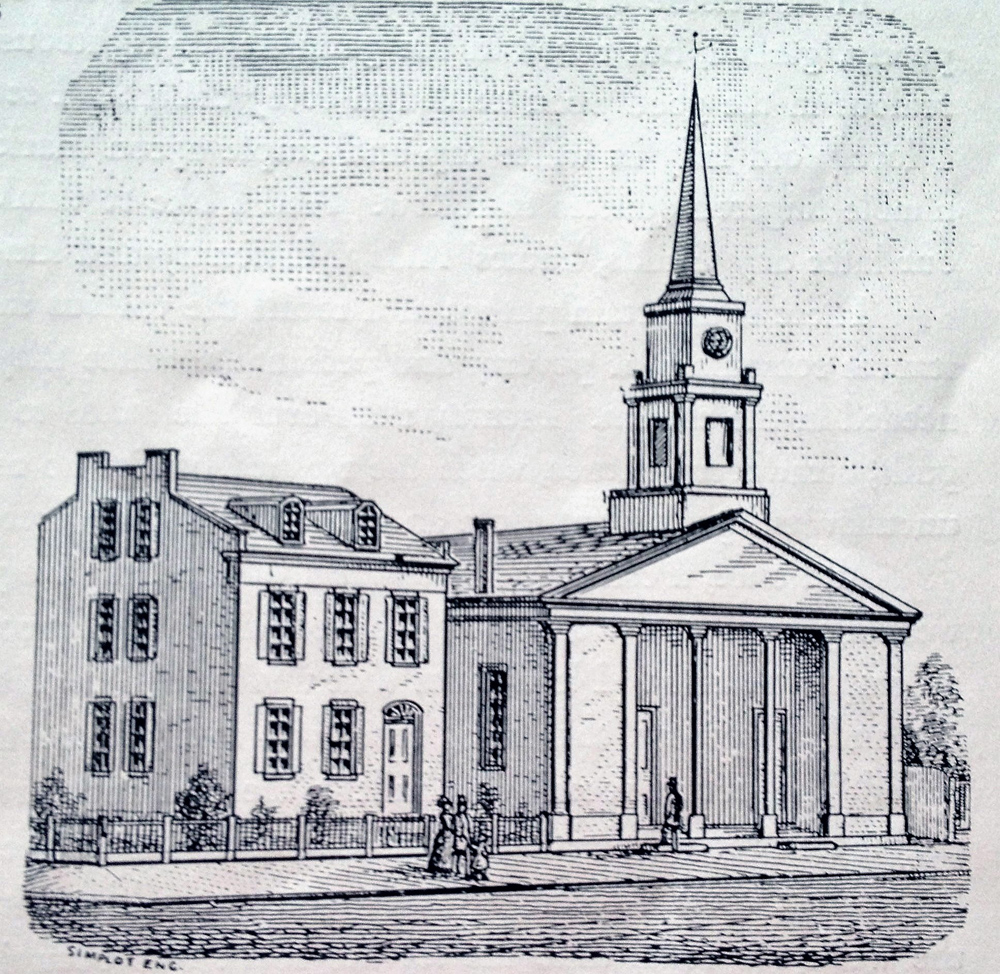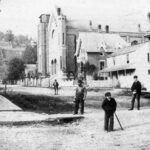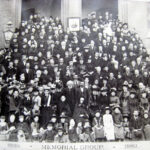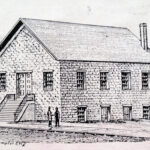Dubuque’s First Congregational United Church of Christ will celebrate its 180th Anniversary in May 2019. The church traces its founding back to May 12, 1839, when nineteen people came together to organize a new Dubuque church under Rev. James A. Clark, a Presbyterian minister employed by the Congregational Home Missionary Society. Although the church had been organized by a Presbyterian, in 1844 the members followed their Puritan heritage and adopted the Congregational form of government, allowing the local congregation to be independent, self-supporting, and self-governed.
In 1844, financial troubles forced the congregation to leave its first permanent home, the Old Stone Church, situated on the east side of Locust St. opposite Washington Park. Temporarily, worship was held in the Court House and then in the Baptist Church.
The congregation rejoiced when their new Main Street Congregational Church was completed in 1846. The building cost an astounding $3,500 and was considered to be unrivaled in architectural beauty. Popular evening revivals brought in so many new members that a $2,700 addition had to be built in 1849.
As more members flocked to First Congregational, the congregation soon outgrew its Main St. building. In 1856, the cornerstone for a new church at 10th and Locust Streets was laid. Unfortunately, the financial panic of 1857 challenged even the most dedicated contributors. Lack of funds halted construction on the new church and some called for the property to be sold. But by July 11, 1858, the church basement was finished – and that’s where the congregation gathered for the first service in the new location.
With the church mired in a $20,000 debt, the new building was still in jeopardy despite the sale of the Main St. property, which netted $13,800 over the initial investment. Dedicated parishioners dug deep into their pockets and raised $10,000, and church member G.D. Wood donated the remainder in gold.
On April 1, 1860, the upstairs sanctuary was finally finished. Reports claim that 900-1,000 attended the dedicatory ceremonies, the largest crowd ever assembled in Dubuque. The church boasted ten soaring stained-glass windows, a rose window in the south gable, four small windows in the north wall, and rows of walnut pews ready for purchase and rental to supply income necessary for the day-to-day operation of the church.
While the members of First Congregational basked in the beauty of their new church, trouble was brewing in the United States. Soon, the Civil War divided the country, the city of Dubuque, and even the membership of First Congregational Church. Most rallied to the cause of liberty and anti-slavery and stood behind Dr. J.C. Holbrook, an ardent abolitionist, but often Dr. Holbrook’s sermons caused Southern sympathizers to stomp out of the church.
Church members celebrated Confederate Gen. Robert E. Lee’s surrender at Appomattox on April 9, 1865, marking the end of the Civil War. Deacon and Union Col. D.E. Lyon enthusiastically rang the church bell throughout the night – until it cracked. It wasn’t until July of 1886 that a new 4,000 pound Clinton H. Meneeley bell was hung in the tower.
In 1869, First Congregational purchased a Johnson’s Opus 277 organ from the W.A. Johnson Company in Westfield, MA at a cost of $4,000. The organ was crated and pulled across the frozen Mississippi on bobsleds since there were no bridges at the time. Once installed, the instrument was said to be the largest and best organ in the West.
In 1875, the red brick and limestone-trimmed church tower was completed at a cost of $3,000. This final project brought the total cost of the 10th St. church to $41,000. Years later, lightning struck the tower twice and in 1918, the elaborate top was removed. The church exterior changed again with the widening of 10th St. The grand outside staircase with its gas lights and newel posts was torn down and replaced with a modest, ground-level entrance.
The two World Wars of the 20th century challenged the congregation. Fifty members answered the call to serve in WWI; three were killed. One hundred and eight served in WWII; five members lost their lives. The church commissioned a bronze plaque for each war to commemorate all who served.
In the 1940s and 1950s, the merger of the Congregational Christian and the Evangelical and Reformed denominations was an oftentimes heated topic of conversation throughout the United States and within the local church. It wasn’t until December of 1960 that Dubuque’s First Congregational Church voted to join the newly organized United Church of Christ (UCC).
In the 1960s, booming Sunday school enrollment challenged the church’s classroom space. In response, a three-story brick educational and administration building was constructed adjacent to the church and dedicated on May 11, 1973. The new construction cost $375,000 – nearly ten times the cost of the original church.
The early years of the 21st century have been marked with major restorations and renovations. The organ was refurbished, the tower was renovated, an electric bell ringer was installed in the tower, the courtyard on Locust St. received a makeover, and an elevator and ADA compliant restrooms were built so that the church is now accessible to all.
That brings us to May 2019 – time to celebrate the church’s 180th Anniversary. It’s time to look back to our Puritan heritage while keeping the message of the UCC firmly before us. “No matter who you are, or where you are on life’s journey, you are welcome here!”
Come join First Congregational UCC for a special anniversary worship service on May 12 at 9:30 a.m. Rumor has it that there will be Pilgrim visitors during the service and Puritan snacks and activities before and after worship!
This article is part of the Shades of Dubuque series, sponsored by Trappist Caskets, hand-made and blessed by the monks at New Melleray Abbey.








Comment here